It’s hard to imagine a time before there were HGVs on our roads, but the haulage industry has changed dramatically in the last 100 years or so. When you look up and down your local high street at some of the old buildings, many of them would have had their bricks and mortar brought in by barrows and horse drawn carts. Since then, the industry has become one of the biggest across the world, driven by technology and the economy. Everything that we buy here in the UK is transported at some point by a UK registered lorry.
So where did it all start?
Steam power
The railways provided transport for large amounts of heavy, voluminous items, which could be moved great distances with relative ease. At last people, as well as goods were able to travel further by the power of the steam train.
The combustion Engine
In the late 1800s the first combustion engine was patented, prompting companies to produce their own vehicles powered by this new innovation, including trucks. As the amount of traffic on the roads increased, so did the quality of the road surfaces themselves – tarmac was first used after its invention in 1901. Pneumatic, or air filled tyres came into use after WW1.
Between the wars
UK haulage grew 300% by the early 1920s. With economic growth, the UKs demand for goods meant that more lorries were needed to transport these goods from factories and ports. The Road Haulage Association was formed in the early 1930s.
Post War
Freight was increasingly transported by road after the war, as the railways struggled to keep up with demand due to a decaying infrastructure and a reliance on steam. A new network of roads allowed increased vehicle size and reduced journey time.
The 60s and 70s
By 1960 there were well over half a million lorries on UK roads. The ‘Golden Age of Road Transport’ continued! As mass manufacturing, and an increase in cheap imports grew, so did the need for a more fluid logistics industry. As this new era drove innovation, lorries continued to change. By the mid-60s the maximum permitted weight for an articulated lorry rose from 24 tons to 32 tons. In 1968 the length limit was raised to 49 feet! In-vehicle accommodation improved allowing lorry drivers to spend weeks away from home.
The 80s and 90s
The early 80s saw the number of five-axle articulated vehicles grow rapidly, whilst in 1989 a directive issued by the European Community increased the maximum permissible weight of certain vehicles, provided they were fitted with ‘road-friendly suspension’. Changes to the industry continued to change into the 90s with more self-employed owner-drivers. Typically the average owner-driver would own one or two HGVs and sign on to a haulage firm as an independent contractor. Safety was improving with the introduction of speed limiters.
Today
The road transport industry has remained relatively stable, although LGV traffic has grown whilst HGV vehicles have reduced. This could be because of the growth in the parcel delivery industry, and many people living in areas where it’s more difficult for lorries to get to.
What is true, is that haulage is the UKs fifth largest employment sector. We think it’s here to stay!
You can find more information about our haulage services here.

